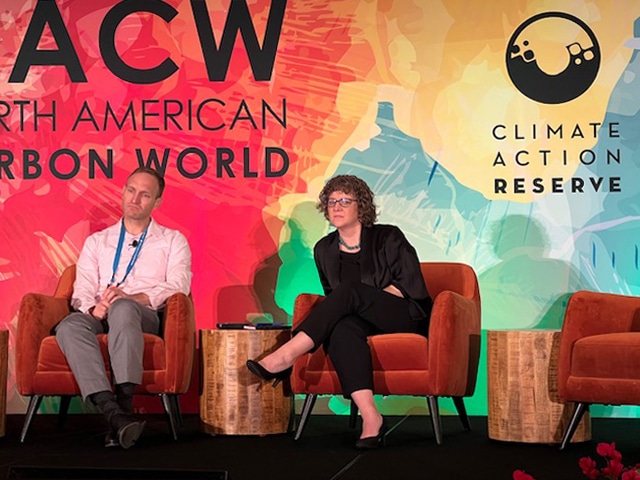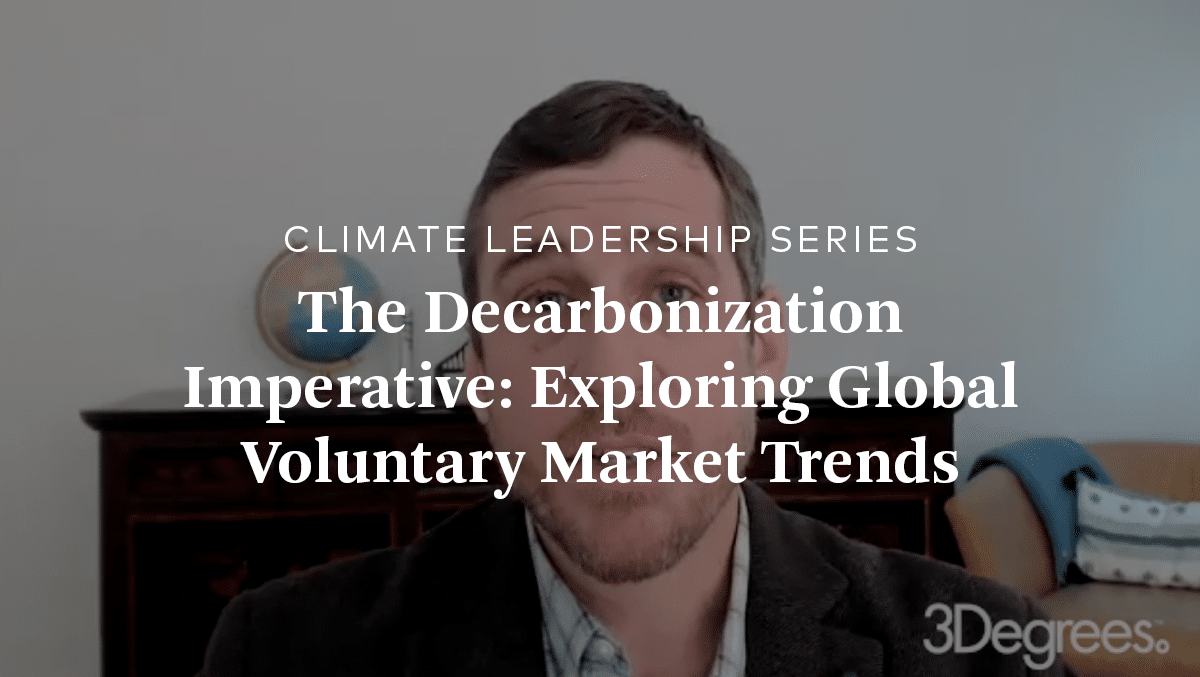
Earlier this month, I was thrilled to reunite (in person!) with friends and colleagues after a long two years at the North American Carbon World (NACW) conference in Anaheim, California. This three-day event brought together leading minds in the world of carbon to discuss, analyze, and critically map the path forward for the global carbon market.
I took part in both high-level musings and detailed, esoteric discussions spanning the many new policies, market trends, and global current events that intersect with carbon markets. There were some common threads woven through the many plenaries, breakout sessions, and hallway conversations. In this blog, I will review a handful of those themes, and share some of my insights as I closed out my experience at NACW 2022.
The challenges and unknowns
War in Ukraine
Beyond the atrocities that are being waged against the people of Ukraine, the unfathomable suffering, and grave human toll there has also been economic shockwaves that have rippled through every global financial market. The voluntary carbon market (VCM) is no exception. Carbon prices have been extremely volatile in the wake of Russia’s aggression. In the early weeks of the war, prices fell nearly 42% within 7 days and before sharply rebounding.
Among other things, this war has highlighted the danger of fossil fuel energy dependence and underscored the need to accelerate the clean energy transition. In the near term, the demand for alternative sources of fossil fuels such as coal and liquified natural gas (LNG) is expected to rise resulting in a global increase in annual emissions. These increased emissions will inevitably result in more demand for offsets, specifically carbon removals as well as a more realistic price for carbon globally.
Article 6 and Corresponding Adjustments
In the months following COP26, the industry has been abuzz with commentary, predictions, and questions on how exactly to interpret the Paris Agreement’s Article 6 framework. Article 6 allows a country to use carbon credits issued for carbon reductions or removals in another country to count towards its own emission reduction target or nationally determined contribution (NDC). These credits will require “Corresponding Adjustments” (CAs) in order to ensure there is no double-counting between countries. The idea is that the “host” country must adjust its own emissions inventory to reflect the transfer of the emissions reduction to another country.

Alexia Kelly Director of Net Zero and Nature at Netflix and Brad Shallert Director of Carbon Market Governance and Aviation at WWF lead a discussion on Driving High Quality Standards in Carbon Markets.
Many questions remain unanswered both from a global regulatory perspective as well as from a voluntary standpoint. Though Article 6 language does not require that CAs be issued for the VCM, this uncertainty leaves some buyers questioning the longevity and legitimacy of current voluntary credits and whether a “Paris-aligned” carbon credit will ultimately reign supreme to support global action toward 1.5 °C under Paris.
The thematic undercurrent of these conversations is that while Article 6 uncertainty continues to loom large in the VCM, we cannot decelerate the financial support of global emissions reduction and removal projects. Every tool available must be leveraged. We must continue to scale capital in the VCM while continuing to construct the Article 6 marketplace.
Investment in Avoided vs. Removal Projects
This question of whether to pursue avoided emissions or carbon removal project investments came up repeatedly in the sessions I attended. It seems that while a rapidly growing number of organizations have formally committed to Net Zero emission targets, there remains little in the way of clear and consistent guidance on the type of credits that will be eligible under the various programs.
It seems some of the confusion lies in a concept that under SBTi’s Net Zero Standard, carbon credits are not permitted in any form to meet either near- or long-term targets. While at the same time, in SBTi’s Beyond Value Chain Mitigation FAQs, it states: “purchasing high-quality carbon credits in addition to reducing emissions along a science-based trajectory can play a critical role in accelerating the transition to net-zero emissions at the global level.”
Despite the rampant confusion over guidance and growing excitement over nascent carbon removal technologies, a consistent response to the repeated question was a “Yes, and”. We need both. We need every tool at our disposal to address the climate crisis. We must preserve existing carbon stocks and critical ecosystems as well as avoid short-lived climate pollutants such as methane from unregulated sectors, while we work to fund emerging carbon removal technologies that will be imperative in a net zero economy.
The solutions – TSSQ (because we all need more acroynms in our lives)
Transparency & Simplification
Many buyers cite lack of transparency as a key contributor to the level of difficulty encountered navigating the carbon markets, specifically the voluntary market. By-and-large, there are very few bad actors that are in the business of trading dodgy credits. And, as someone who develops carbon credits for a living, I would be remiss not to point out that the verification process is extremely rigorous! We conclude that buyers are simply confused. The level of education, time, access, and scrutiny required to screen projects across the market would be a daunting task for most buyers. Straight-forward and unfettered access to project-level information will allow buyers to “get under the hood” on their project investments and help instill a higher level of confidence in the marketplace.
Standardization
Another common theme at the conference was a need to build more standardization across the voluntary carbon market – from project screening, reporting and claims on the buy side, to validation criteria on the sell side. Some in attendance theorized that at some point in the not-too-distant future, the compliance markets and voluntary markets will converge into one universal compulsory market, bringing to bear a much clearer and unified framework. Absent that, market experts see technology playing a large role in bringing about this standardization. By converging disparate platforms, we can build a common language spurring further confidence and capital in the VCM.
Quality
Without confidence in the market, there is no market. Confidence is earned by ensuring that the VCM consists of high-quality, high-integrity attributes. By staying laser-focused on upholding carbon credit quality, institutional investors will be further incentivized to participate in the VCM. More unlocked capital means more investment in the innovative technologies that are needed to accelerate the pace to global net zero.Programs like the VCM Integrity Initiative and The Carbon Credit Quality Initiative are building systematized ways for buyers to better understand the projects they are investing in and providing clear guidelines for making solid, credible claims. These measures provide the assurance necessary to build the internal business case and mobilize financing at scale.
Parting thoughts from North American Carbon World
I left NACW with renewed excitement and a solid belief that the state of the market is strong. With unprecedented new carbon investments, strong and growing market prices, and the emergence of game-changing technologies, it feels as though we’re at an inflection point.
Like any market, there are many complex factors that can sharply influence stability or volatility within the VCM. I find comfort in distilling these factors into simple, digestible terms. The simplest and most sound vision for building a thriving VCM was outlined by Alexia Kelly, Director of Net Zero & Nature at Netflix in her session Driving High Quality Standards in Carbon Markets. She described achieving scale in the VCM through three key pillars:
To 1) Ensure high quality credits are 2) traded in markets with high integrity and transparency and are 3) moved in ways that are universally accepted.
The market is primed, we have the tools, and I am excited to see how this market grows and matures on our collective path to meeting the challenge of 1.5 °C.



Recent Comments